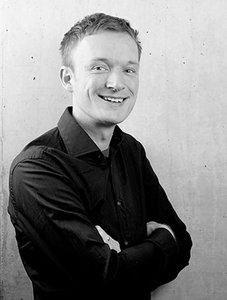
Highlights
Institute's News
New research group 'Computational Biology and Evolutionary Genomics'
The joint junior research group between our institute and the MPI of Molecular Cellbiology and Genetics is headed by Dr. Michael
Hiller and uses computational approaches to link phenotypic differences between species to differences in their genomes, which is key to understand how nature’s phenotypic diversity evolved.
Read moreInstitute's News
New research group 'Collective Dynamics of Cells'
The research group headed by Dr. Vasily Zaburdaev develops and applies methods of statistical physics helping to understand complex biological phenomena.
Read morePublication Highlights
The weak password problem: chaos, criticality, and encrypted p-CAPTCHAs
Vulnerabilities related to weak passwords are a pressing global economic and security issue. We report a novel, simple, and effective approach to address the weak password problem. Building upon chaotic dynamics, criticality at phase transitions, CAPTCHA recognition, and computational round-off errors we design an algorithm that strengthens security of passwords. The core idea of our method is to split a long and secure password into two components. The first component is memorized by the user. The second component is transformed into a CAPTCHA image and then protected using evolution of a two-dimensional dynamical system close to a phase transition, in such a way that standard brute-force attacks become ineffective. We expect our approach to have wide applications for authentication and encryption technologies.
T.V.Laptyeva, S. Flach, K. Kladko
arXiv:1103.6219v1 (2011)
Read morePublication Highlights
Dynamics of Dpp Signaling and Proliferation Control
Morphogens, such as Decapentaplegic (Dpp) in the fly imaginal discs, form graded concentration profiles that control patterning and growth of developing organs. In the imaginal discs, proliferative growth is homogeneous in space, posing the conundrum of how morphogen concentration gradients could control position-independent growth. To understand the mechanism of proliferation control by the Dpp gradient, we quantified Dpp concentration and signaling levels during wing disc growth. Both Dpp concentration and signaling gradients scale with tissue size during development. On average, cells divide when Dpp signaling levels have increased by 50%. Our observations are consistent with a growth control mechanism based on temporal changes of cellular morphogen signaling levels. For a scaling gradient, this mechanism generates position-independent growth rates.
O. Wartlick, P. Mumcu, A. Kicheva, T. Bittig, C. Seum, F. Jülicher, M. González-Gaitán
Science 331, 1154 (2011)
Read morePublication Highlights
Emerging local Kondo screening and spatial coherence in the heavy-fermion metal YbRh$_2$Si$_2$
The entanglement of quantum states is both a central concept in fundamental physics and a potential tool for realizing advanced materials and applications. The quantum superpositions underlying entanglement are at the heart of the intricate interplay of localized spin states and itinerant electronic states that gives rise to the Kondo effect in certain dilute magnetic alloys. In systems where the density of localized spin states is sufficiently high, they can no longer be treated as non-interacting; if they form a dense periodic array, a Kondo lattice may be established1. Such a Kondo lattice gives rise to the emergence of charge carriers with enhanced effective masses, but the precise nature of the coherent Kondo state responsible for the generation of these heavy fermions remains highly debated. Here we use atomic-resolution tunnelling spectroscopy to investigate the low-energy excitations of a generic Kondo lattice system, YbRh$_2$Si$_2$. We find that the hybridization of the conduction electrons with the localized 4f electrons results in a decrease in the tunnelling conductance at the Fermi energy. In addition, we observe unambiguously the crystal-field excitations of the Yb$^{3+}$ ions. A strongly temperature-dependent peak in the tunnelling conductance is attributed to the Fano resonance resulting from tunnelling into the coherent heavy-fermion states that emerge at low temperature. Taken together, these features reveal how quantum coherence develops in heavy 4f-electron Kondo lattices. Our results demonstrate the efficiency of real-space electronic structure imaging for the investigation of strong electronic correlations, specifically with respect to coherence phenomena, phase coexistence and quantum criticality.
S. Ernst, S. Kirchner, C. Krellner, C. Geibel, G. Zwicknagel, F. Steglich & S. Wirth
Nature 474, 362 (2011)
Read moreInstitute's News
New research group 'Topology and Correlations in Condensed Matter'
The research group is headed by Dr. Frank Pollmann and focuses on the study of topological phases of matter, the dynamics in disordered systems, and the applications of quantum information concepts to quantum many-body systems.
Read moreAwards and Honors
EMBO Young Investigator Award 2010
Dr. Stephan Grill
EMBO chooses some of the best young group leaders in Europe, through a highly competitive annual selection to join the EMBO Young Investigator programme. During their three-year tenure in the programme, EMBO Young Investigators receive a range of financial and practical benefits. These support them during a critical stage of their career, and help them realize their potential as world-class researchers.
Read moreAwards and Honors
Gustav-Hertz-Preis 2010 der DPG
Thomas Pohl vom Dresdner Max-Planck-Institut für Physik komplexer Systeme erhält den mit 7.500 Euro dotierten „Gustav-Hertz-Preis“ der Deutschen Physikalischen Gesellschaft. Der 31-jährige Wissenschaftler wird für seine theoretischen Arbeiten zur Erzeugung von Anti-Wasserstoff ausgezeichnet. Dieses künstlich hergestellte Element ist das Pendant zum natürlich vorkommenden Wasserstoff. Es besteht aus Antimaterie: nämlich aus einem elektrisch negativ geladenen Anti-Proton und einem positiv geladenen Positron. Das Interesse für Anti-Wasserstoff rührt daher, dass sich an derlei künstlich hergestellten Atomen fundamentale Theorien der Physik überprüfen lassen.
Read moreInstitute's News
New research group 'Dynamical Systems and Social Dynamics'
The Otto Hahn Group is headed by Dr. Eduardo Altmann and applies complexity theory to data of human activities.
Read morePublication Highlights
Coupling a sensory hair-cell bundle to cyber clones enhances nonlinear amplification
The vertebrate ear benefits from nonlinear mechanical amplification to operate over a vast range of sound intensities. The amplificatory process is thought to emerge from active force production by sensory hair cells. The mechano-sensory hair bundle that protrudes from the apical surface of each hair cell can oscillate spontaneously and function as a frequency-selective, nonlinear amplifier. Intrinsic fluctuations, however, jostle the response of a single hair bundle to weak stimuli and seriously limit amplification. Most hair bundles are mechanically coupled by overlying gelatinous structures. Here, we assayed the effects of mechanical coupling on the hair-bundle amplifier by combining dynamic force clamp of a hair bundle from the bullfrog’s saccule with real-time stochastic simulations of hair-bundle mechanics. This setup couples the hair bundle to two virtual hair bundles, called cyber clones, and mimics a situation in which the hair bundle is elastically linked to two neighbors with similar characteristics. We found that coupling increased the coherence of spontaneous hair-bundle oscillations. By effectively reducing noise, the synergic interplay between the hair bundle and its cyber clones also enhanced amplification of sinusoidal stimuli. All observed effects of coupling were in quantitative agreement with simulations. We argue that the auditory amplifier relies on hair-bundle cooperation to overcome intrinsic noise limitations and achieve high sensitivity and sharp frequency selectivity.
Jérémie Barral, Kai Dierkes, Benjamin Lindner, Frank Jülicher, Pascal Martin
PNAS 107 (18), 8079 (2010)
Read more





